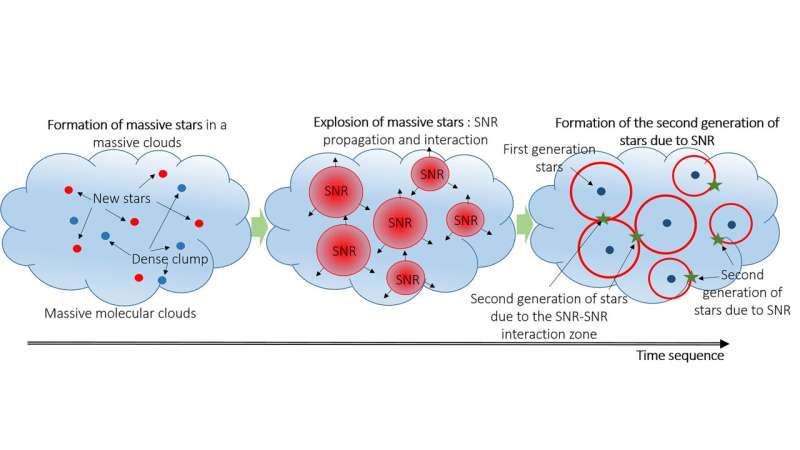Simulating supernova remnants, star formation in earthbound lab

Molecular clouds are collections of gas and dust in space. When left alone, the clouds remain in their state of peaceful equilibrium.
But when triggered by some external agent, like supernova remnants, shockwaves can propagate through the gas and dust to create pockets of dense material. At a certain limit, that dense gas and dust collapses and begins to form new stars.
Astronomical observations do not have high enough spatial resolution to observe these processes, and numerical simulations cannot handle the complexity of the interaction between clouds and supernova remnants. Therefore, the triggering and formation of new stars in this way remains mostly shrouded in mystery.
In Matter and Radiation at Extremes, researchers from the Polytechnic Institute of Paris, the Free University of Berlin, the Joint Institute for High Temperatures of the Russian Academy of Sciences, the Moscow Engineering Physics Institute, the French Alternative Energies and Atomic Energy Commission, the University of Oxford, and Osaka University modeled the interaction between supernova remnants and molecular clouds using a high-power laser and a foam ball.
The foam ball represents a dense area within a molecular cloud. The high-power laser creates a blast wave that propagates through a surrounding chamber of gas and into the ball, where the team observed the compression using X-ray images.
“We are really looking at the beginning of the interaction,” said author Bruno Albertazzi. “In this way, you can see if the average density of the foam increases and if you will begin to form stars more easily.”
The mechanisms for triggering star formation are interesting on a number of scales. They can impact the star formation rate and evolution of a galaxy, help explain the formation of the most massive stars, and have consequences in our own solar system.
“Our primitive molecular cloud, where the sun was formed, was probably triggered by supernova remnants,” said author Albertazzi. “This experiment opens a new and promising path for laboratory astrophysics to understand all these major points.”
While some of the foam compressed, some of it also stretched out. This changed the average density of the material, so in the future, the authors will need to account for the stretched mass to truly measure the compressed material and the shockwave’s impact on star formation. They plan to explore the influence of radiation, magnetic field, and turbulence.
“This first paper was really to demonstrate the possibilities of this new platform opening a new topic that could be investigated using high-power lasers,” said Albertazzi.
Image: Nebula churns out massive stars in new Hubble image
Triggering star formation: Experimental compression of a foam ball induced by Taylor-Sedov blast waves, Matter and Radiation at Extremes (2022). aip.scitation.org/doi/full/10.1063/5.0068689
Citation:
Simulating supernova remnants, star formation in earthbound lab (2022, April 12)
retrieved 13 April 2022
from https://phys.org/news/2022-04-simulating-supernova-remnants-star-formation.html
This document is subject to copyright. Apart from any fair dealing for the purpose of private study or research, no
part may be reproduced without the written permission. The content is provided for information purposes only.
For all the latest Science News Click Here
For the latest news and updates, follow us on Google News.

